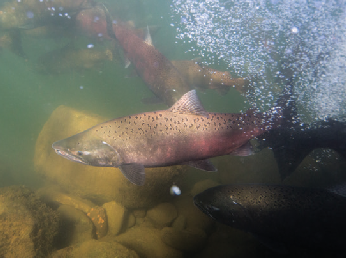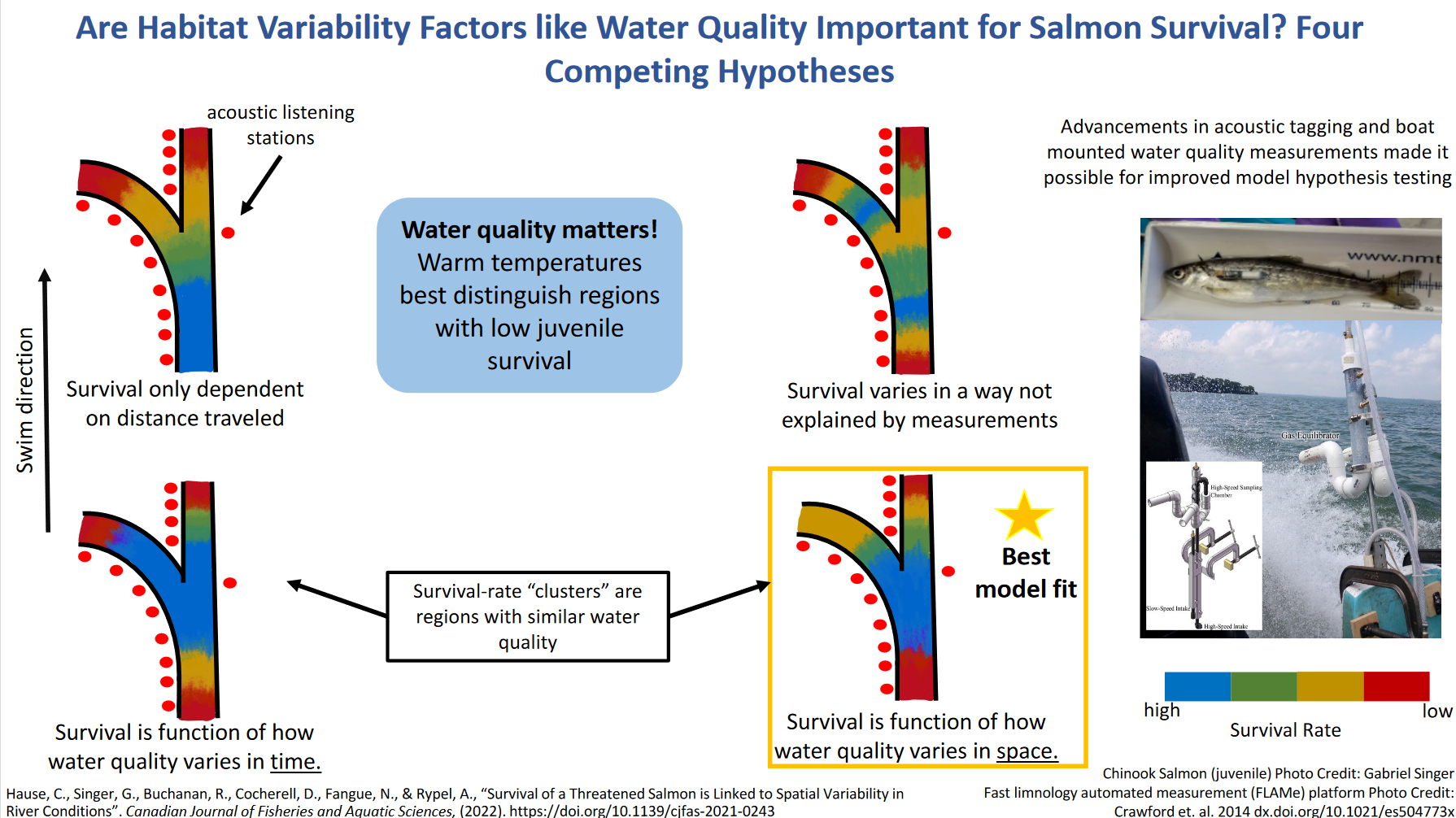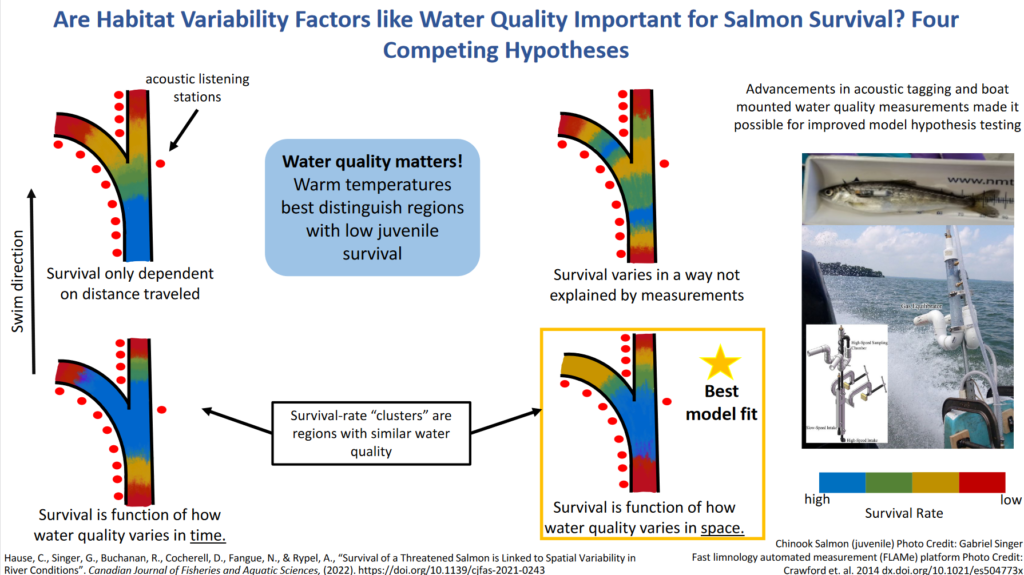At the November meeting of the Delta Stewardship Council, Delta Lead Scientist Laurel Larsen spotlighted research funded by the Council that examined whether water quality is a factor in juvenile salmon mortality with a somewhat surprising result. She also updated the Council on the discovery of nutria on Lower Sherman Island and a workshop scheduled for the spring of 2023 on the development of a ‘collaboratory.’
Article spotlight: Are Habitat Variability Factors like Water Quality Important for Salmon Survival? Four Competing Hypotheses
Spring run Chinook salmon are a threatened species notable for having been completely extirpated from the San Joaquin River due to the construction of dams that prevent them from reaching their historical spawning grounds. Habitat restoration on the tributaries of the San Joaquin River is an ongoing focus of habitat restoration efforts, including in the Bay Delta Water Quality Control Plan update and the recent voluntary agreements.
The San Joaquin River Restoration Program has been working to reintroduce Chinook salmon to the river; however, despite these efforts, only about 5% of the juvenile salmon reintroduced to the San Joaquin River survive their trip through the Delta to the ocean.
Much effort has been focused on why the survival rate is so low, considering factors such as predation, habitat structure, or flow. However, few studies have attempted to understand how survival might be a function of other aspects, such as water quality, which encompasses a range of factors, including turbidity, nutrients, contaminants, and water temperature.
In the paper, Survival of a Threatened Salmon is Linked to Spatial Variability in River Conditions, the team of authors led by Colby Hause sought to fill in this gap in understanding with a study funded through the Council’s 2018 PSN. The researchers took advantage of recent technological advances that have expanded the range of hypotheses scientists can test regarding fish behavior and survival, particularly through improved monitoring capabilities using acoustic telemetry.
In the past, the only way to collect information about fish distributions and populations was by going out in a boat and collecting fish through labor-intensive and expensive sampling. Now, however, other options are particularly useful for tracking the fate of hatchery-raised salmon. One of those options are small acoustic tags that can be injected into young fish that emit a pinging that can be picked up by the robust network of acoustic receivers or listening stations installed throughout the Delta. This gives continuous information about where the tagged fish are, which enables researchers to infer when and where fish die. So the researchers used the dataset to address competing hypotheses about what causes spatial differences in survival through the Delta, which is key to understanding whether differences in water quality strongly influence survival rates.
To address these hypotheses, the survival data and information about water quality from sampling were combined. Researchers then created predictive models of survival that assigned different survival rates to different parts of the Delta, represented by different colors in the set of figures on the slide below.
In the first model, shown on the upper left of the slide, survival was assumed to be governed by distance from the Golden Gate or distance downstream. In the second model on the upper right, a different survival rate was assigned to each river increment between stations; this model assumed no correlation between water quality or distance and survival, but rather that survival varies spatially due to unknown or undescribed factors.
In the third and fourth models shown on the bottom, different river reaches were grouped or clustered with other river reaches with similar water quality; those river reaches were assigned the same survival probability in the model. However, those two models differed in how the clusters were designated; on the bottom left, reaches in which water quality changes similarly over time were grouped together, whereas on the bottom right, reaches in which the time-averaged water quality was similar were grouped together.
“In each of these four models, the value of survival assigned to each spatial cluster was determined by what would create the best fit to the data,” explained Dr. Larsen. “The quality of the model fit was then evaluated through a metric that estimates how generalizable the model might be based on both accuracy and the number of parameters being fit.”
“So according to this statistical analysis, the model that emerged on the top was the one in which survival was explainable by how water quality varies in space on the bottom right,” she continued. “So in plain English, this means that different water quality in different parts of the Delta is predictably associated with different rates of salmon survival.”
Dr. Larsen noted that the study did not get specifically at the relative importance of water quality compared to other potential drivers like flow or even what specific aspects of water quality might be contributing to the different survival rates.
 However, the research team did look at the regions of the Delta with the lowest survival and what aspects of water quality were shared among those locations. “They found that surprisingly, the upstream restoration region within the tributaries had some of the lowest survival rates, along with the main stem central Delta. The one factor consistent across those two locations was water temperature, which was warmer than average in both locations. So while the water temperatures themselves were unlikely to have been lethal for the salmon smolt, warm water temperatures have been associated with more predation by non-native species in the Delta and could influence the body size and swimming ability of the fish.”
However, the research team did look at the regions of the Delta with the lowest survival and what aspects of water quality were shared among those locations. “They found that surprisingly, the upstream restoration region within the tributaries had some of the lowest survival rates, along with the main stem central Delta. The one factor consistent across those two locations was water temperature, which was warmer than average in both locations. So while the water temperatures themselves were unlikely to have been lethal for the salmon smolt, warm water temperatures have been associated with more predation by non-native species in the Delta and could influence the body size and swimming ability of the fish.”
“This is yet another study that emphasizes the importance of understanding temperature in planning restoration efforts and anticipating the success of management actions, such as fish reintroductions, or understanding why certain management actions were or were not successful.”
Councilman Don Nottoli expressed concern that millions of dollars are being spent on restoration in the upper watershed, and this study seems to indicate less than optimum outcomes for Chinook salmon. Is there any interface with project proponents? If this issue relates to at least in part temperature, there needs to be some resolution. If not, he can see where the investment would fall short of expectations.
The 2022-26 Science Action Agenda recognized that there is still a great need to understand how interacting stressors impact managed species, such as spring-run Chinook salmon. “One of the challenges with drawing management-related conclusions from a study like this is that it looks at four different hypotheses for what governs survival rate, but there were other things that are left out, such as flow. It could be the case that these different water quality clusters actually covary or vary in a similar way to variables that were not included in the study, so there’s a need to understand how interacting factors drive differences in survival rate to really know where we need to pinpoint in our management actions. So I would say there is widespread recognition that more work must continue to diagnose these surprisingly low survival rates in the upstream restoration region.”
“Also, within the science program, we are prioritizing our ability to close the loop and bring relevant information back to the management community. One of the ways that we’re doing that right now is we’re holding some listening sessions among the project teams that we fund through the PSN that study similar types of topics. In addition, we regularly participate in synthesis activities that try to draw the big picture story out of many individual studies and provide that in a way that’s highly communicable to managers. So it’s a little bit of a hand-wavy answer, but I would say that all of the things you mentioned are priorities for us in the science program.”

Executive officer Jessica Pearson noted that the main focus of the Delta Science Program is to provide the best unbiased scientific information to decision-makers. “So we have the DPIIC restoration subcommittee. We’re fostering all sorts of conversations to make sure that interaction is happening. We’re advising on projects. And we require people to develop adaptive management plans, so if they learn more, they can make changes. I think the entire ecosystem amendment was based on the understanding that there’s so much we don’t know, but we do know some things about what helps the species. So a no-regrets approach is just to get some of that acreage on the ground to create a diversity of habitats and increase the odds of survival.”
Ms. Pearson also noted that the focus of the Water Board and the update to the Bay Delta Water Quality Control Plan is water quality, of which a big component is temperature. “So there’s a lot of money going into studying how much water to lower or raise the temperature. Can we even control that? And is it effective? And what kind of impact is it having on the species? So it’s a big topic in California water management.”
Nutria found on Sherman Island
The Department of Fish and Wildlife recently reported that nutria were seen on Lower Sherman Island on a camera system in August. DFW began trapping in October, placing 150 traps and catching eight nutria between October 25 and 28.
Nutria are large invasive rodents that can be hugely destructive to wetlands. “It’s a big deal that nutria were detected and trapped on lower Sherman island because it’s quite a large distance from the last place of detection,” said Dr. Larsen, noting that there have been no additional detections since October 28.
DFW maintains a nutria webpage that is regularly updated with any recent detections, and DFW is diligent about updating and contacting Delta agencies about any new developments with nutria.
Modeling Collaboratory Workshop
The Delta Science Program and a planning group that includes Integrated Modeling Steering Committee members are planning a workshop titled “Integrated Modeling Framework Workshop: One Delta, One Science, One Modeling Framework.” The workshop is scheduled for March 1-2, 2023, and will advance the first steps in developing a collaborative open science modeling community.
“There’s a bit of debate internally about whether or not to call this a collaboratory,” Dr. Larsen said. “The challenge with that term is that people don’t tend to know what it means. But here, when we use the term collaboratory, we’re talking about a community and a set of open source tools for advancing integrated transparent modeling to better inform resource management decisions.”
The workshop will include plenary presentations, panel discussions, and breakout sessions. Through these opportunities, participants will curate a set of case studies for which a collaboratory can or would have made a big difference in resource management. They’ll engage in opportunities to collaborate and discuss technology needs and the detailed components of the modeling framework.
“We anticipate that a big outcome of this workshop will be a detailed proposal for moving the collaboratory forward, including a plan to address funding needs,” she said.
Delta Lead Scientist Ask Me Anything sessions resume
Dr. Larsen has resumed her Ask Me Anything sessions on Zoom rather than Instagram. The Monday session was co-hosted by Henry DeBey, the Council’s new Deputy Executive Officer for Science. The discussion focused on science priorities and on how Mr. DeBey’s career up to this point has influenced his thinking about the Delta Science Program.
Workshop reports
More details on the recent Bay-Delta Social Science Community of Practice: Advancing Interdisciplinary Research event and the Water Temperature Modeling Platform Independent Review Panel Report are available in the Delta Lead Scientist written report below (or available online here).
2022-11-17-item-10-lead-scientist-report



